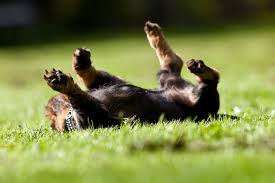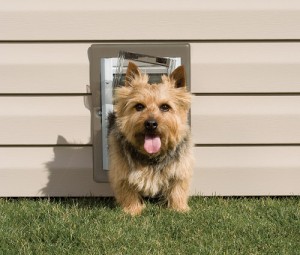[s2If current_user_cannot(access_s2member_ccap_course_001_bm)]
To view this lesson, please purchase this course or log in if you have already purchased it.[/s2If]
[s2If current_user_can(access_s2member_ccap_course_001_bm)]
WHY IS MY DOG DOING THIS?
 It’s actually pretty simple. Frustration comes from behavior that’s supposed to work a certain way being blocked or not working. It’s unclear what he should do to get what he needs or wants.
It’s actually pretty simple. Frustration comes from behavior that’s supposed to work a certain way being blocked or not working. It’s unclear what he should do to get what he needs or wants.
We can be just as frustrating to our dogs as they are to us. So what do we do about it? One thing is to look at what needs the dog has that are not being met, and help him have ways to meet those needs. We’ll discuss that more in depth in lessons 3 and 4, but here’s a taste.
When we bring a dog into our home, we become his caretaker. Simply by having the dog in human society, in our homes or on our property, we have taken away many of the ways that dogs are able to meet their own needs. Just like caretakers at a modern zoo, our roles as canine caretakers is to provide ways for dogs meet their needs. In this lesson, I have split dogs’ needs into the following categories.
- Safety and comfort
- Survival of the species/social group (reproduction)
- Food/Water Intake
- Food/Water Outlet
- Family / Social Interaction
- Other Environmental Enrichment
I’ll comment a bit on each category above.
Safety means both physical and emotional safety. With our dogs, that means only having them in situations that they can handle, and helping them feel comfortable in a variety of situations. It’s our responsibility to provide and prepare our dogs for grooming required for health and comfort (like tooth brushing and nail trimming for all breeds and fur brushing or even trimming for some breeds) and veterinary care, including vaccinations to prevent disease. Vaccines save lives, but they are not entirely benign. Don’t skip necessary vaccines, but also look into whether a particular vaccine is really needed for your dog’s lifestyle and location.
Physical exercise is primarily in the safety category, because insufficient exercise is a health risk. We must do so in a safe way, however, like training a solid recall and using a leash and harness near traffic. It also means not letting them run off leash toward on-leash dogs, and also removing the leash (if it’s safe) or leaving the area if a loose dog comes to them. I cringe whenever I see a poor puppy on a leash surrounded by dogs. No matter how friendly the dogs are, it’s quite scary for the puppy, who has nowhere to go. He’s like bait on a rope. If the area is enclosed and the dogs are friendly and well socialized, you might choose to let your dog off-leash. Otherwise, it’s probably best to move on and avoid the stress.
Part of physical safety is protection from the elements, with my preference being that the dog lives indoors, with the family, and gets enough sleep. Adult dogs rest 12 to 16 hours each day and a 3-month old puppy would need more like 15 or 20 hours per day. That means paying attention to where his sleeping areas are, keeping children out of there, etc. After exciting play times, don’t just leave your dog all revved up. Do something to help him relax afterwards, like scattering a handful of treats in your yard or doing calm massage.
The individual dog needs to be safe, but the species and the family also need to survive. Humans know that dogs are doing pretty well as a species, and in fact we have more dogs than we can care for. Not every dog needs to breed. But it is our responsibility to encourage breeders to select mentally and physically sound dogs that thrive in human care. I’m on my soapbox here, but we owe our dogs a good future as a species and that means we need to stop breeding for looks at the expense of sanity and health.
 Food and water need to go in and out of your dog’s system on a regular basis. Nutrition is beyond the scope of this course, but do pay attention to the food that goes into your puppy’s body. A dog’s diet has an effect on energy levels, overall health, lifespan, receptivity to training, and even can contribute to anxiety and other behavioral issues.
Food and water need to go in and out of your dog’s system on a regular basis. Nutrition is beyond the scope of this course, but do pay attention to the food that goes into your puppy’s body. A dog’s diet has an effect on energy levels, overall health, lifespan, receptivity to training, and even can contribute to anxiety and other behavioral issues.
Water should be available to your dog at all times and never withdrawn as punishment. Make sure you have water available even when your dog is alone, rather than taking it up to avoid the need to urinate.
For food and water to get out of your dog’s body in a way that you don’t mind, your dog needs regular walks or access to the outdoors. Leaving your dog outside all day, however, may introduce him to certain things he’s not able to handle, like teasing children. He may learn to bark at passersby because he is afraid of them or is trying to get their attention. The same applies to a dog door being open when you are not home.
According to the Association of Zoos and Aquariums article on enrichment, environmental enrichment is “the dynamic process for enhancing animal environments within the context of the animals’ behavioral biology and natural history.” Environmental enrichment is basically about giving the animals a chance to make choices that matter.
 AZA writes, “Environmental changes are made with the goal of increasing the animals’ behavioral choices and drawing out their species-appropriate behaviors, thus enhancing animal welfare.” Enrichment includes natural social groupings to promote social interaction, as well as sensory enrichment, food enrichment, and training. We can do a lot of this with our dogs. For example:
AZA writes, “Environmental changes are made with the goal of increasing the animals’ behavioral choices and drawing out their species-appropriate behaviors, thus enhancing animal welfare.” Enrichment includes natural social groupings to promote social interaction, as well as sensory enrichment, food enrichment, and training. We can do a lot of this with our dogs. For example:
- Having more than one dog in your home (not always possible or advisable)
- Play dates or walks with other dogs
- Learning to understand our dogs’ behavior
- Early socialization with many dogs outside of the family, so that your dog understands how to communicate with his own species (and wants to)
- Not continuously training (allow natural behaviors and choices whenever possible)
- Going for walks in places with interesting smells, surfaces, etc.
- Food puzzles of various complexity (more on that later in this lecture)
- More odors, puzzles, sounds, etc. if dog is housebound
- Training that serves a purpose for the dog (focus on behaviors that help the dog)
Those are all needs that dogs might have. In the moment, your dog may have a particular need or even a want. Have these needs in mind when you observe your dog’s behavior. Teach specific behavior that helps him communicate his wants and needs. We’ll discuss this more later in the course.
[/s2If]